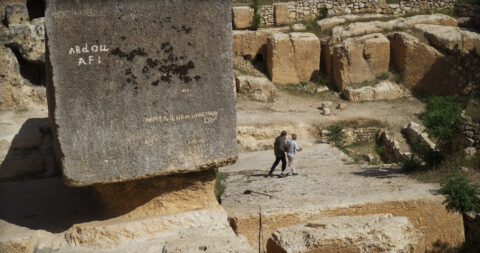You can do a lot of things to rocks.
They can be exploded, chopped, ground, emulsified. Made into a paste. They can even form the basis of concrete. It’s the sworn enemy of famed architect Michele De Lucchi, whose enigmatic presence, bedecked in a striking black jacket and hat, powers Victor Kossakovsky’s experimental diatribe against the world’s second most used substance in the world after water.
Kossakovsky combines two films in one. One is a slow, immersive documentary, with awe-inspiring shots of mines, mountains and slag heaps, bombed-out or disaster-struck buildings and ancient Greek and Roman monuments — eventually leading up to the creation of concrete itself. The other follows De Lucchi’s attempts to create a circle made of rocks in his garden, his collaborators carefully creating something that both complements and belongs to nature.
As Peter Griffin would say, “It insists upon itself.” From the interminable opening credits to Evgueni Galperine’s grandiose score to the endless rows upon rows of devastation porn, Architecton (2024) is a film that impresses its grandeur upon you. But it’s also an insecure film, tacking on its thesis about the true problem with concrete right at the end, almost as if to make sure you really got what Kossokovsky wanted to say.
Shot in an ultra-high frame rate, Architecton looks incredible when it comes to certain footage — capturing each tiny fragment of stone or drop of rain — but odd in the drone shots and even worse when capturing human movement. At one point, I grasped unconsciously for the remote. Alas, I couldn’t turn the motion smoothing off.
This attention to super-clarity detail recalls the sharpness of Baraka (Ron Fricke, 1992) — a wonderful non-narrative documentary filmed in 70mm and scanned at 8K resolution. But Architecton lacks the inner propulsion of Fricke’s film, unable to combine the images to be truly engaging.
The conclusions are suspect too. Opening with a devasted Ukraine is powerful at first, but this use of wartorn buildings, later complemented by housing projects flattened by earthquakes in Turkey, is highly suspect. Given that these tragedies are caused by war and corruption respectively, the use of this footage is tenuous at best, offensive at worst. Yes, concrete is bad, and yes, we should probably use other building methods. But it’s probably not Ukraine or Turkey’s biggest problem right now. Given it’s so widely used, Kossokovsky certainly should’ve looked elsewhere to make a more impactful point.
Redmond is the editor-in-chief of Journey Into Cinema.
